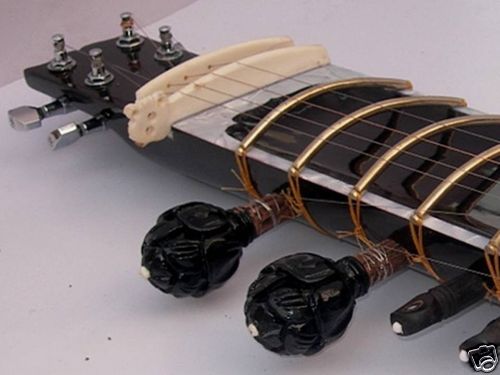
| 
www.ElectricSitar.Info I created this page because there have been some recent innovations to this very old instrument, and it's almost impossible to find any information about the changes. Although electric pick-ups have been installed in acoustic sitars for quite some time, only recently has this been combined with making sitars with a flat back instead of the traditional bulging gourd. This change might sound minor, but it opens up the acoustic-electric sitar to Western players in a way that was never before possible, and I am eager to encourage others who are of the experimental nature. |

|
I experiment quite a bit with instruments, and I'm attracted to East-West fusion music, so it's not surprising that I've wanted a sitar for a long time. Unfortunately, the less expensive acoustic sitars sold on the internet are more likely tourist-level wall hangings than playable instruments and, being on limited income, I simply couldn't afford a really good acoustic sitar. Acoustic-electric sitar, however, sounded like an option I could afford. After much hesitation and research, I took the plunge and purchased this instrument made by Bhargava & Co. of Mumbai, India. I like it! |

|
3) Can you play it standing up - like a guitar? |

|
5) What's the deal with the guitar tuners at the top? |

|
6) Where are they made and what is the quality like? |
9) What about sitars that are based more on Western instruments like guitars & citterns?

|
|
Yes, there are some exciting innovations happening here as luthiers continue experimenting with how to get a sitar sound out of Western instruments. Here is the most exciting one I've seen - the Pygmy Sitar being manufactured in the UK by Pygmy Instruments. The scalloped neck on the two top strings is designed to allow for easy bends on the melody, while the remaining six strings create the sympathetic drone. The body looks to be from a cittern, so it has natural acoustic resonance. The combination of a piezo pick-up with a condensor mic pointed right at the adjustable buzz bridge makes for an excellent amplified sound. It doesn't look as exotic as the regular acoustic-electric sitar and it lacks the full range of sympathetic strings, but it appears to be more stable and easily mastered for those who already play guitar or cittern.

|
10) What about those "electric sitars" sold by Rogue (STR-1) or Agile that are basically electric guitars with sympathetic strings and a buzzing Gotoh bridge? |
11) What about G Rosul electric sitars?
Now, here we have an actual electric sitar. The main difference between this and a Rogue STR-1 is the sitar frets instead of guitar frets. I haven't seen one of the new fusion models made in India by G Rosul that combine a sitar top with a solid-body. At $700-plus for an entry level instrument, I'm unlikely to see one very soon either. It is an intriguing idea. If the pick-ups are clean enough and the sympathetic strings sensitive enough, it might work. I will withhold judgment until I actually hear one.

G Rosul

|
12) What about sitar pedals for electric guitars? |
Larry "at" LCarter.Com (obviously substituting @ for "at")
|
since September 18th, 2009 | 
|
